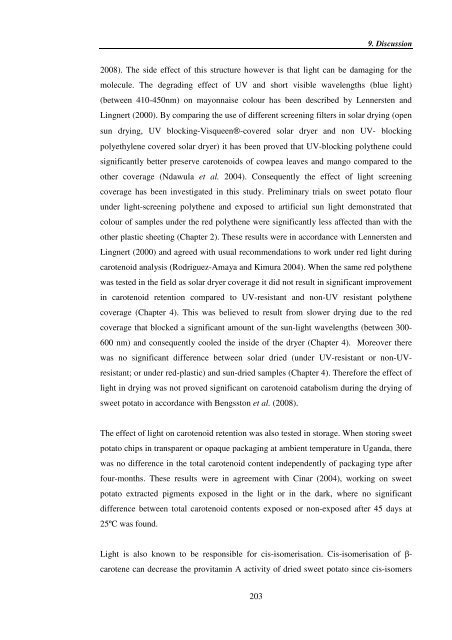Investigating carotenoid loss after drying and storage of
Investigating carotenoid loss after drying and storage of
Investigating carotenoid loss after drying and storage of
You also want an ePaper? Increase the reach of your titles
YUMPU automatically turns print PDFs into web optimized ePapers that Google loves.
203<br />
9. Discussion<br />
2008). The side effect <strong>of</strong> this structure however is that light can be damaging for the<br />
molecule. The degrading effect <strong>of</strong> UV <strong>and</strong> short visible wavelengths (blue light)<br />
(between 410-450nm) on mayonnaise colour has been described by Lennersten <strong>and</strong><br />
Lingnert (2000). By comparing the use <strong>of</strong> different screening filters in solar <strong>drying</strong> (open<br />
sun <strong>drying</strong>, UV blocking-Visqueen®-covered solar dryer <strong>and</strong> non UV- blocking<br />
polyethylene covered solar dryer) it has been proved that UV-blocking polythene could<br />
significantly better preserve <strong>carotenoid</strong>s <strong>of</strong> cowpea leaves <strong>and</strong> mango compared to the<br />
other coverage (Ndawula et al. 2004). Consequently the effect <strong>of</strong> light screening<br />
coverage has been investigated in this study. Preliminary trials on sweet potato flour<br />
under light-screening polythene <strong>and</strong> exposed to artificial sun light demonstrated that<br />
colour <strong>of</strong> samples under the red polythene were significantly less affected than with the<br />
other plastic sheeting (Chapter 2). These results were in accordance with Lennersten <strong>and</strong><br />
Lingnert (2000) <strong>and</strong> agreed with usual recommendations to work under red light during<br />
<strong>carotenoid</strong> analysis (Rodriguez-Amaya <strong>and</strong> Kimura 2004). When the same red polythene<br />
was tested in the field as solar dryer coverage it did not result in significant improvement<br />
in <strong>carotenoid</strong> retention compared to UV-resistant <strong>and</strong> non-UV resistant polythene<br />
coverage (Chapter 4). This was believed to result from slower <strong>drying</strong> due to the red<br />
coverage that blocked a significant amount <strong>of</strong> the sun-light wavelengths (between 300-<br />
600 nm) <strong>and</strong> consequently cooled the inside <strong>of</strong> the dryer (Chapter 4). Moreover there<br />
was no significant difference between solar dried (under UV-resistant or non-UV-<br />
resistant; or under red-plastic) <strong>and</strong> sun-dried samples (Chapter 4). Therefore the effect <strong>of</strong><br />
light in <strong>drying</strong> was not proved significant on <strong>carotenoid</strong> catabolism during the <strong>drying</strong> <strong>of</strong><br />
sweet potato in accordance with Bengsston et al. (2008).<br />
The effect <strong>of</strong> light on <strong>carotenoid</strong> retention was also tested in <strong>storage</strong>. When storing sweet<br />
potato chips in transparent or opaque packaging at ambient temperature in Ug<strong>and</strong>a, there<br />
was no difference in the total <strong>carotenoid</strong> content independently <strong>of</strong> packaging type <strong>after</strong><br />
four-months. These results were in agreement with Cinar (2004), working on sweet<br />
potato extracted pigments exposed in the light or in the dark, where no significant<br />
difference between total <strong>carotenoid</strong> contents exposed or non-exposed <strong>after</strong> 45 days at<br />
25ºC was found.<br />
Light is also known to be responsible for cis-isomerisation. Cis-isomerisation <strong>of</strong> !-<br />
carotene can decrease the provitamin A activity <strong>of</strong> dried sweet potato since cis-isomers






